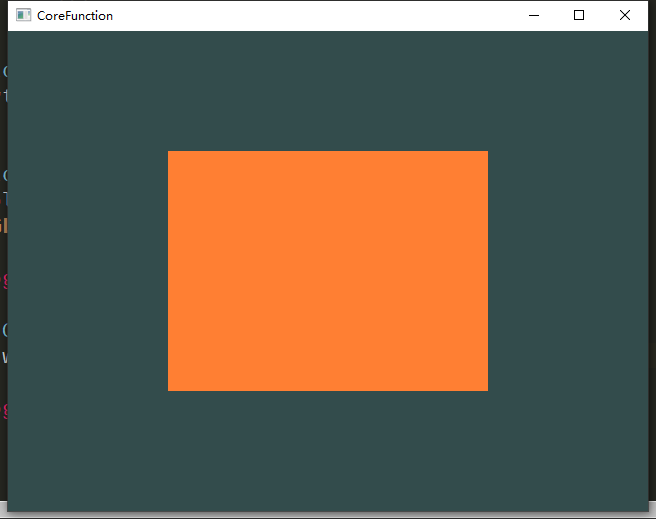简介
要学习OpenGL的话,强烈安利这个教程JoeyDeVries的learnopengl,这里是中文翻译好的版本。教程中使用OpenGL是通过GLFW这个库,而在Qt中对OpenGL封装得很好,并且和GUI以及IO相关的处理Qt更便捷,学习起来更轻松。这里就对每篇教程,在Qt在分别直接使用OpenGL的函数和Qt封装好的类以作对比。
教程中使用的OpenGL版本为3.3,在Qt中需要使用此版本的OpenGL只需要继承类QOpenGLFunctions_3_3_Core即可。如果为了在不同设备上都能用OpenGL的话,Qt提供了类QOpenGLFunctions,这个类包含了大部分公共的函数,可能会有个别函数不能用。
对比说明
教程地址
原教程地址,相关知识可以点击链接学习。
我的工程地址,准备后期每篇教程一个commit,查看本篇代码 git checkout v1.1,喜欢就点个Star吧~
不同点
- 原教程关于ShaderProgram的读取、链接很繁琐,后面教程还专门写了个类
Shader,这里我直接使用Qt封装好的addShaderFromSourceFile函数更方便。 - Qt提供了
QOpenGLShaderProgram、QOpenGLVertexArrayObject、QOpenGLBuffer这些类来处理OpenGL中的program、VAO、VBO。
运行结果
使用OpenGL函数版
CoreFunctionWidget.h
#ifndef COREFUNCTIONWIDGET_H
#define COREFUNCTIONWIDGET_H
#include
#include
#include
#include
#include
class CoreFunctionWidget : public QOpenGLWidget
, protected /*QOpenGLExtraFunctions*/QOpenGLFunctions_3_3_Core
{
Q_OBJECT
public:
explicit CoreFunctionWidget(QWidget *parent = nullptr);
~CoreFunctionWidget();
protected:
virtual void initializeGL();
virtual void resizeGL(int w, int h);
virtual void paintGL();
private:
QOpenGLShaderProgram shaderProgram;
};
#endif // COREFUNCTIONWIDGET_H
CoreFunctionWidget.cpp
#include "CoreFunctionWidget.h"
#include
#include
static GLuint VBO, VAO, EBO;
CoreFunctionWidget::CoreFunctionWidget(QWidget *parent) : QOpenGLWidget(parent)
{
}
CoreFunctionWidget::~CoreFunctionWidget()
{
glDeleteVertexArrays(1, &VAO);
glDeleteBuffers(1, &VBO);
// glDeleteBuffers(1, &EBO);
}
void CoreFunctionWidget::initializeGL(){
this->initializeOpenGLFunctions();
bool success = shaderProgram.addShaderFromSourceFile(QOpenGLShader::Vertex, ":/triangle.vert");
if (!success) {
qDebug() << "shaderProgram addShaderFromSourceFile failed!" << shaderProgram.log();
return;
}
success = shaderProgram.addShaderFromSourceFile(QOpenGLShader::Fragment, ":/triangle.frag");
if (!success) {
qDebug() << "shaderProgram addShaderFromSourceFile failed!" << shaderProgram.log();
return;
}
success = shaderProgram.link();
if(!success) {
qDebug() << "shaderProgram link failed!" << shaderProgram.log();
}
//VAO,VBO数据部分
float vertices[] = {
0.5f, 0.5f, 0.0f, // top right
0.5f, -0.5f, 0.0f, // bottom right
-0.5f, -0.5f, 0.0f, // bottom left
-0.5f, 0.5f, 0.0f // top left
};
unsigned int indices[] = { // note that we start from 0!
0, 1, 3, // first Triangle
1, 2, 3 // second Triangle
};
glGenVertexArrays(1, &VAO);
glGenBuffers(1, &VBO);
glGenBuffers(1, &EBO);
// bind the Vertex Array Object first, then bind and set vertex buffer(s), and then configure vertex attributes(s).
glBindVertexArray(VAO);
glBindBuffer(GL_ARRAY_BUFFER, VBO);
glBufferData(GL_ARRAY_BUFFER, sizeof(vertices), vertices, GL_STATIC_DRAW); //顶点数据复制到缓冲
glBindBuffer(GL_ELEMENT_ARRAY_BUFFER, EBO);
glBufferData(GL_ELEMENT_ARRAY_BUFFER, sizeof(indices), indices, GL_STATIC_DRAW);
glVertexAttribPointer(0, 3, GL_FLOAT, GL_FALSE, 3 * sizeof(GLfloat), (void*)0);//告诉程序如何解析顶点数据
glEnableVertexAttribArray(0);
glBindBuffer(GL_ARRAY_BUFFER, 0);//取消VBO的绑定, glVertexAttribPointer已经把顶点属性关联到顶点缓冲对象了
// remember: do NOT unbind the EBO while a VAO is active as the bound element buffer object IS stored in the VAO; keep the EBO bound.
// glBindBuffer(GL_ELEMENT_ARRAY_BUFFER, 0);
// You can unbind the VAO afterwards so other VAO calls won't accidentally modify this VAO, but this rarely happens. Modifying other
// VAOs requires a call to glBindVertexArray anyways so we generally don't unbind VAOs (nor VBOs) when it's not directly necessary.
glBindVertexArray(0); //取消VAO绑定
//线框模式,QOpenGLExtraFunctions没这函数, 3_3_Core有
// glPolygonMode(GL_FRONT_AND_BACK, GL_LINE);
}
void CoreFunctionWidget::resizeGL(int w, int h){
glViewport(0, 0, w, h);
}
void CoreFunctionWidget::paintGL(){
glClearColor(0.2f, 0.3f, 0.3f, 1.0f);
glClear(GL_COLOR_BUFFER_BIT);
shaderProgram.bind();
glBindVertexArray(VAO); // seeing as we only have a single VAO there's no need to bind it every time, but we'll do so to keep things a bit more organized
// glDrawArrays(GL_TRIANGLES, 0, 6);
glDrawElements(GL_TRIANGLES, 6, GL_UNSIGNED_INT, 0);
shaderProgram.release();
}
使用Qt相关函数版
QtFunctionWidget.h
#ifndef QTFUNCTIONWIDGET_H
#define QTFUNCTIONWIDGET_H
#include
#include
#include
#include
#include
#include
#include
#include
class QtFunctionWidget : public QOpenGLWidget, protected QOpenGLFunctions
{
public:
QtFunctionWidget(QWidget *parent = nullptr);
~QtFunctionWidget() Q_DECL_OVERRIDE;
protected:
virtual void initializeGL() Q_DECL_OVERRIDE;
virtual void resizeGL(int w, int h) Q_DECL_OVERRIDE;
virtual void paintGL() Q_DECL_OVERRIDE;
private:
QOpenGLShaderProgram shaderProgram;
QOpenGLBuffer vbo, ebo;
QOpenGLVertexArrayObject vao;
};
#endif // QTFUNCTIONWIDGET_H
QtFunctionWidget.cpp
#include "QtFunctionWidget.h"
#include
QtFunctionWidget::QtFunctionWidget(QWidget *parent) : QOpenGLWidget (parent),
vbo(QOpenGLBuffer::VertexBuffer),
ebo(QOpenGLBuffer::IndexBuffer)
{
}
QtFunctionWidget::~QtFunctionWidget(){
makeCurrent();
vbo.destroy();
ebo.destroy();
vao.destroy();
doneCurrent();
}
void QtFunctionWidget::initializeGL(){
this->initializeOpenGLFunctions();
bool success = shaderProgram.addShaderFromSourceFile(QOpenGLShader::Vertex, ":/triangle.vert");
if (!success) {
qDebug() << "shaderProgram addShaderFromSourceFile failed!" << shaderProgram.log();
return;
}
success = shaderProgram.addShaderFromSourceFile(QOpenGLShader::Fragment, ":/triangle.frag");
if (!success) {
qDebug() << "shaderProgram addShaderFromSourceFile failed!" << shaderProgram.log();
return;
}
success = shaderProgram.link();
if(!success) {
qDebug() << "shaderProgram link failed!" << shaderProgram.log();
}
//VAO,VBO数据部分
GLfloat vertices[] = {
0.5f, 0.5f, 0.0f, // top right
0.5f, -0.5f, 0.0f, // bottom right
-0.5f, -0.5f, 0.0f, // bottom left
-0.5f, 0.5f, 0.0f // top left
};
unsigned int indices[] = { // note that we start from 0!
0, 1, 3, // first Triangle
1, 2, 3 // second Triangle
};
QOpenGLVertexArrayObject::Binder vaoBind(&vao);
vbo.create();
vbo.bind();
vbo.allocate(vertices, sizeof(vertices));
ebo.create();
ebo.bind();
ebo.allocate(indices, sizeof(indices));
int attr = -1;
attr = shaderProgram.attributeLocation("aPos");
shaderProgram.setAttributeBuffer(attr, GL_FLOAT, 0, 3, sizeof(GLfloat) * 3);
shaderProgram.enableAttributeArray(attr);
vbo.release();
// remember: do NOT unbind the EBO while a VAO is active as the bound element buffer object IS stored in the VAO; keep the EBO bound.
// ebo.release();
}
void QtFunctionWidget::resizeGL(int w, int h){
glViewport(0, 0, w, h);
}
void QtFunctionWidget::paintGL(){
glClearColor(0.2f, 0.3f, 0.3f, 1.0f);
glClear(GL_COLOR_BUFFER_BIT);
shaderProgram.bind();
{
QOpenGLVertexArrayObject::Binder vaoBind(&vao);
glDrawElements(GL_TRIANGLES, 6, GL_UNSIGNED_INT, 0);
}
shaderProgram.release();
}
GLSL
triangle.vert
#version 330 core
layout(location = 0) in vec3 aPos;
void main(){
gl_Position = vec4(aPos.x, aPos.y, aPos.z, 1.0f);
}
triangle.frag
#version 330 core
out vec4 FragColor;
void main(){
FragColor = vec4(1.0f, 0.5f, 0.2f, 1.0f);
}
main.cpp
#include
#include "MainWindow.h"
#include "QtFunctionWidget.h"
#include "CoreFunctionWidget.h"
int main(int argc, char *argv[])
{
QApplication a(argc, argv);
// MainWindow w;
QtFunctionWidget w1;
CoreFunctionWidget w2;
w1.setWindowTitle(QObject::tr("QtFunction"));
w2.setWindowTitle(QObject::tr("CoreFunction"));
w1.show();
w2.show();
return a.exec();
}
